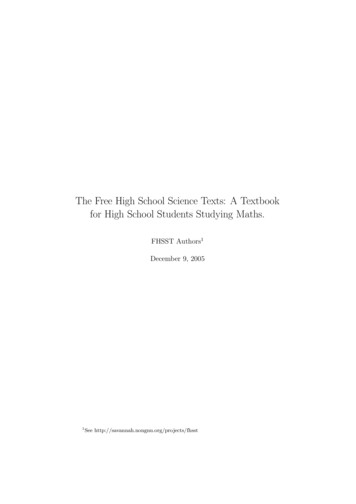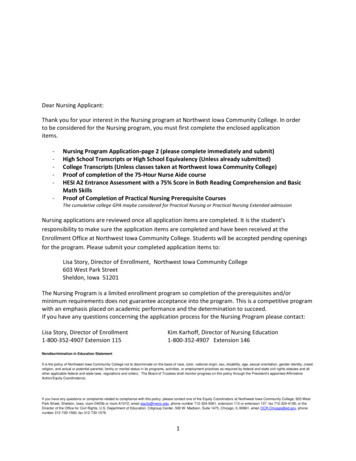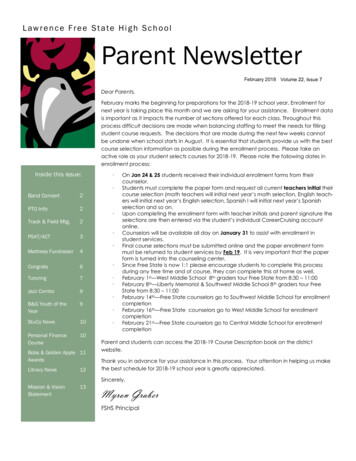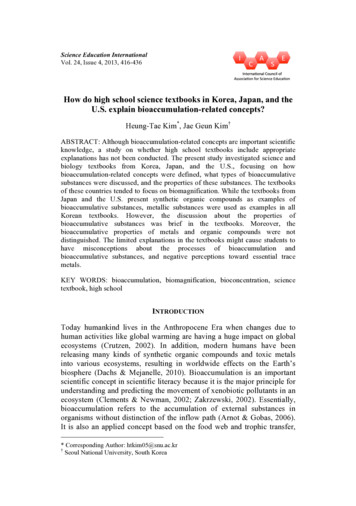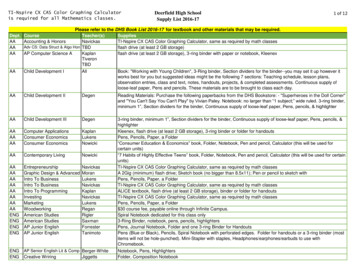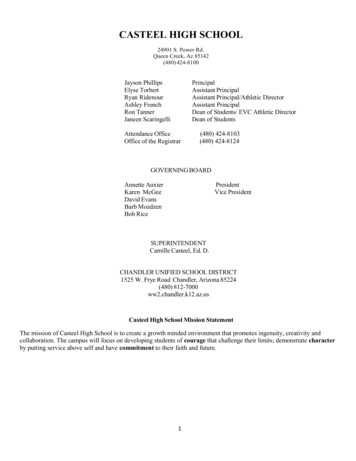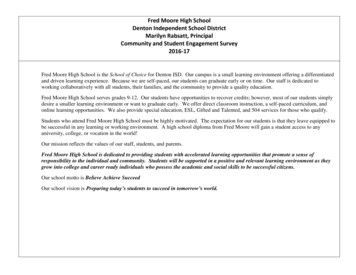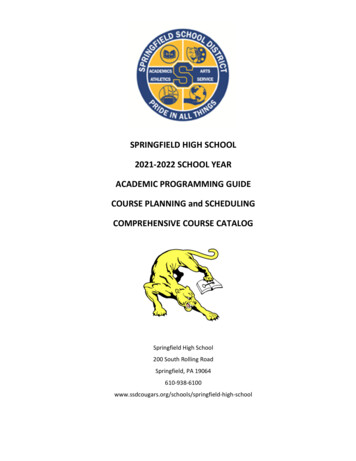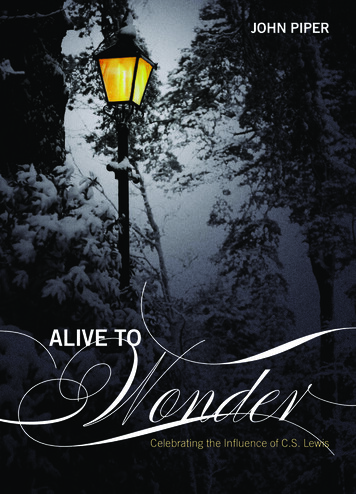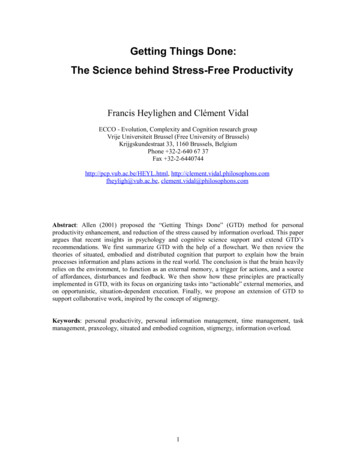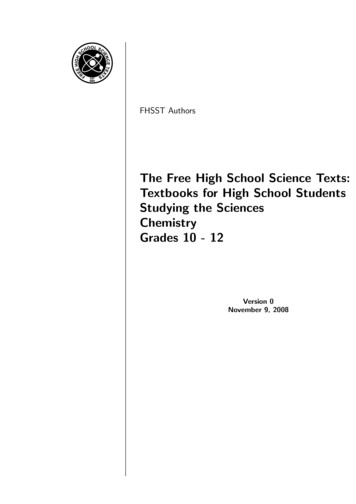
Transcription
FHSST AuthorsThe Free High School Science Texts:Textbooks for High School StudentsStudying the SciencesChemistryGrades 10 - 12Version 0November 9, 2008
iiCopyright 2007 “Free High School Science Texts”Permission is granted to copy, distribute and/or modify this document under theterms of the GNU Free Documentation License, Version 1.2 or any later versionpublished by the Free Software Foundation; with no Invariant Sections, no FrontCover Texts, and no Back-Cover Texts. A copy of the license is included in thesection entitled “GNU Free Documentation License”.STOP!!!!Did you notice the FREEDOMS we’ve granted you?Our copyright license is different! It grants freedomsrather than just imposing restrictions like all those othertextbooks you probably own or use. We know people copy textbooks illegally but we would LOVE it if you copiedour’s - go ahead copy to your hearts content, legally! Publishers’ revenue is generated by controlling the market, we don’t want anymoney, go ahead, distribute our books far and wide - we DARE you! Ever wanted to change your textbook? Of course you have! Go ahead, changeours, make your own version, get your friends together, rip it apart and putit back together the way you like it. That’s what we really want! Copy, modify, adapt, enhance, share, critique, adore, and contextualise. Doit all, do it with your colleagues, your friends, or alone but get involved!Together we can overcome the challenges our complex and diverse countrypresents. So what is the catch? The only thing you can’t do is take this book, makea few changes and then tell others that they can’t do the same with yourchanges. It’s share and share-alike and we know you’ll agree that is only fair. These books were written by volunteers who want to help support education,who want the facts to be freely available for teachers to copy, adapt andre-use. Thousands of hours went into making them and they are a gift toeveryone in the education community.
FHSST Core TeamMark Horner ; Samuel Halliday ; Sarah Blyth ; Rory Adams ; Spencer WheatonFHSST EditorsJaynie Padayachee ; Joanne Boulle ; Diana Mulcahy ; Annette Nell ; René Toerien ; DonovanWhitfieldFHSST ContributorsRory Adams ; Prashant Arora ; Richard Baxter ; Dr. Sarah Blyth ; Sebastian Bodenstein ;Graeme Broster ; Richard Case ; Brett Cocks ; Tim Crombie ; Dr. Anne Dabrowski ; LauraDaniels ; Sean Dobbs ; Fernando Durrell ; Dr. Dan Dwyer ; Frans van Eeden ; GiovanniFranzoni ; Ingrid von Glehn ; Tamara von Glehn ; Lindsay Glesener ; Dr. Vanessa Godfrey ; Dr.Johan Gonzalez ; Hemant Gopal ; Umeshree Govender ; Heather Gray ; Lynn Greeff ; Dr. TomGutierrez ; Brooke Haag ; Kate Hadley ; Dr. Sam Halliday ; Asheena Hanuman ; Neil Hart ;Nicholas Hatcher ; Dr. Mark Horner ; Robert Hovden ; Mfandaidza Hove ; Jennifer Hsieh ;Clare Johnson ; Luke Jordan ; Tana Joseph ; Dr. Jennifer Klay ; Lara Kruger ; Sihle Kubheka ;Andrew Kubik ; Dr. Marco van Leeuwen ; Dr. Anton Machacek ; Dr. Komal Maheshwari ;Kosma von Maltitz ; Nicole Masureik ; John Mathew ; JoEllen McBride ; Nikolai Meures ;Riana Meyer ; Jenny Miller ; Abdul Mirza ; Asogan Moodaly ; Jothi Moodley ; Nolene Naidu ;Tyrone Negus ; Thomas O’Donnell ; Dr. Markus Oldenburg ; Dr. Jaynie Padayachee ;Nicolette Pekeur ; Sirika Pillay ; Jacques Plaut ; Andrea Prinsloo ; Joseph Raimondo ; SanyaRajani ; Prof. Sergey Rakityansky ; Alastair Ramlakan ; Razvan Remsing ; Max Richter ; SeanRiddle ; Evan Robinson ; Dr. Andrew Rose ; Bianca Ruddy ; Katie Russell ; Duncan Scott ;Helen Seals ; Ian Sherratt ; Roger Sieloff ; Bradley Smith ; Greg Solomon ; Mike Stringer ;Shen Tian ; Robert Torregrosa ; Jimmy Tseng ; Helen Waugh ; Dr. Dawn Webber ; MichelleWen ; Dr. Alexander Wetzler ; Dr. Spencer Wheaton ; Vivian White ; Dr. Gerald Wigger ;Harry Wiggins ; Wendy Williams ; Julie Wilson ; Andrew Wood ; Emma Wormauld ; SahalYacoob ; Jean YoussefContributors and editors have made a sincere effort to produce an accurate and useful resource.Should you have suggestions, find mistakes or be prepared to donate material for inclusion,please don’t hesitate to contact us. We intend to work with all who are willing to help makethis a continuously evolving resource!www.fhsst.orgiii
iv
ContentsIIIIntroduction1Matter and Materials31 Classification of Matter - Grade 101.11.25Mixtures . . . . . . . . . . . . . . . . . . . . . . . . . . . . . . . . . . . . . . .51.1.1Heterogeneous mixtures . . . . . . . . . . . . . . . . . . . . . . . . . . .61.1.2Homogeneous mixtures . . . . . . . . . . . . . . . . . . . . . . . . . . .61.1.3Separating mixtures . . . . . . . . . . . . . . . . . . . . . . . . . . . . .7Pure Substances: Elements and Compounds . . . . . . . . . . . . . . . . . . . .91.2.1Elements . . . . . . . . . . . . . . . . . . . . . . . . . . . . . . . . . . .91.2.2Compounds . . . . . . . . . . . . . . . . . . . . . . . . . . . . . . . . .91.3Giving names and formulae to substances . . . . . . . . . . . . . . . . . . . . . 101.4Metals, Semi-metals and Non-metals . . . . . . . . . . . . . . . . . . . . . . . . 131.4.1Metals . . . . . . . . . . . . . . . . . . . . . . . . . . . . . . . . . . . . 131.4.2Non-metals . . . . . . . . . . . . . . . . . . . . . . . . . . . . . . . . . 141.4.3Semi-metals . . . . . . . . . . . . . . . . . . . . . . . . . . . . . . . . . 141.5Electrical conductors, semi-conductors and insulators . . . . . . . . . . . . . . . 141.6Thermal Conductors and Insulators . . . . . . . . . . . . . . . . . . . . . . . . . 151.7Magnetic and Non-magnetic Materials . . . . . . . . . . . . . . . . . . . . . . . 171.8Summary . . . . . . . . . . . . . . . . . . . . . . . . . . . . . . . . . . . . . . . 182 What are the objects around us made of? - Grade 10212.1Introduction: The atom as the building block of matter . . . . . . . . . . . . . . 212.2Molecules . . . . . . . . . . . . . . . . . . . . . . . . . . . . . . . . . . . . . . 212.2.1Representing molecules . . . . . . . . . . . . . . . . . . . . . . . . . . . 212.3Intramolecular and intermolecular forces . . . . . . . . . . . . . . . . . . . . . . 252.4The Kinetic Theory of Matter . . . . . . . . . . . . . . . . . . . . . . . . . . . . 262.5The Properties of Matter . . . . . . . . . . . . . . . . . . . . . . . . . . . . . . 282.6Summary . . . . . . . . . . . . . . . . . . . . . . . . . . . . . . . . . . . . . . . 313 The Atom - Grade 103.135Models of the Atom . . . . . . . . . . . . . . . . . . . . . . . . . . . . . . . . . 353.1.1The Plum Pudding Model . . . . . . . . . . . . . . . . . . . . . . . . . . 353.1.2Rutherford’s model of the atomv. . . . . . . . . . . . . . . . . . . . . . 36
CONTENTS3.1.33.23.3CONTENTSThe Bohr Model . . . . . . . . . . . . . . . . . . . . . . . . . . . . . . . 37How big is an atom? . . . . . . . . . . . . . . . . . . . . . . . . . . . . . . . . 383.2.1How heavy is an atom? . . . . . . . . . . . . . . . . . . . . . . . . . . . 383.2.2How big is an atom? . . . . . . . . . . . . . . . . . . . . . . . . . . . . 38Atomic structure . . . . . . . . . . . . . . . . . . . . . . . . . . . . . . . . . . . 383.3.1The Electron . . . . . . . . . . . . . . . . . . . . . . . . . . . . . . . . . 393.3.2The Nucleus . . . . . . . . . . . . . . . . . . . . . . . . . . . . . . . . . 393.4Atomic number and atomic mass number . . . . . . . . . . . . . . . . . . . . . 403.5Isotopes . . . . . . . . . . . . . . . . . . . . . . . . . . . . . . . . . . . . . . . 423.63.73.83.93.5.1What is an isotope? . . . . . . . . . . . . . . . . . . . . . . . . . . . . . 423.5.2Relative atomic mass . . . . . . . . . . . . . . . . . . . . . . . . . . . . 45Energy quantisation and electron configuration . . . . . . . . . . . . . . . . . . 463.6.1The energy of electrons . . . . . . . . . . . . . . . . . . . . . . . . . . . 463.6.2Energy quantisation and line emission spectra . . . . . . . . . . . . . . . 473.6.3Electron configuration . . . . . . . . . . . . . . . . . . . . . . . . . . . . 473.6.4Core and valence electrons . . . . . . . . . . . . . . . . . . . . . . . . . 513.6.5The importance of understanding electron configuration . . . . . . . . . 51Ionisation Energy and the Periodic Table . . . . . . . . . . . . . . . . . . . . . . 533.7.1Ions . . . . . . . . . . . . . . . . . . . . . . . . . . . . . . . . . . . . . 533.7.2Ionisation Energy . . . . . . . . . . . . . . . . . . . . . . . . . . . . . . 55The Arrangement of Atoms in the Periodic Table . . . . . . . . . . . . . . . . . 563.8.1Groups in the periodic table. . . . . . . . . . . . . . . . . . . . . . . . 563.8.2Periods in the periodic table . . . . . . . . . . . . . . . . . . . . . . . . 58Summary . . . . . . . . . . . . . . . . . . . . . . . . . . . . . . . . . . . . . . . 594 Atomic Combinations - Grade 11634.1Why do atoms bond? . . . . . . . . . . . . . . . . . . . . . . . . . . . . . . . . 634.2Energy and bonding . . . . . . . . . . . . . . . . . . . . . . . . . . . . . . . . . 634.3What happens when atoms bond? . . . . . . . . . . . . . . . . . . . . . . . . . 654.4Covalent Bonding . . . . . . . . . . . . . . . . . . . . . . . . . . . . . . . . . . 654.4.1The nature of the covalent bond . . . . . . . . . . . . . . . . . . . . . . 654.5Lewis notation and molecular structure . . . . . . . . . . . . . . . . . . . . . . . 694.6Electronegativity . . . . . . . . . . . . . . . . . . . . . . . . . . . . . . . . . . . 724.74.84.6.1Non-polar and polar covalent bonds . . . . . . . . . . . . . . . . . . . . 734.6.2Polar molecules . . . . . . . . . . . . . . . . . . . . . . . . . . . . . . . 73Ionic Bonding . . . . . . . . . . . . . . . . . . . . . . . . . . . . . . . . . . . . 744.7.1The nature of the ionic bond . . . . . . . . . . . . . . . . . . . . . . . . 744.7.2The crystal lattice structure of ionic compounds . . . . . . . . . . . . . . 764.7.3Properties of Ionic Compounds . . . . . . . . . . . . . . . . . . . . . . . 76Metallic bonds . . . . . . . . . . . . . . . . . . . . . . . . . . . . . . . . . . . . 764.8.1The nature of the metallic bond . . . . . . . . . . . . . . . . . . . . . . 764.8.2The properties of metals . . . . . . . . . . . . . . . . . . . . . . . . . . 77vi
CONTENTS4.9CONTENTSWriting chemical formulae. . . . . . . . . . . . . . . . . . . . . . . . . . . . . 784.9.1The formulae of covalent compounds . . . . . . . . . . . . . . . . . . . . 784.9.2The formulae of ionic compounds . . . . . . . . . . . . . . . . . . . . . 804.10 The Shape of Molecules . . . . . . . . . . . . . . . . . . . . . . . . . . . . . . . 824.10.1 Valence Shell Electron Pair Repulsion (VSEPR) theory . . . . . . . . . . 824.10.2 Determining the shape of a molecule . . . . . . . . . . . . . . . . . . . . 824.11 Oxidation numbers . . . . . . . . . . . . . . . . . . . . . . . . . . . . . . . . . 854.12 Summary . . . . . . . . . . . . . . . . . . . . . . . . . . . . . . . . . . . . . . . 885 Intermolecular Forces - Grade 11915.1Types of Intermolecular Forces . . . . . . . . . . . . . . . . . . . . . . . . . . . 915.2Understanding intermolecular forces . . . . . . . . . . . . . . . . . . . . . . . . 945.3Intermolecular forces in liquids . . . . . . . . . . . . . . . . . . . . . . . . . . . 965.4Summary . . . . . . . . . . . . . . . . . . . . . . . . . . . . . . . . . . . . . . . 976 Solutions and solubility - Grade 111016.1Types of solutions . . . . . . . . . . . . . . . . . . . . . . . . . . . . . . . . . . 1016.2Forces and solutions . . . . . . . . . . . . . . . . . . . . . . . . . . . . . . . . . 1026.3Solubility . . . . . . . . . . . . . . . . . . . . . . . . . . . . . . . . . . . . . . . 1036.4Summary . . . . . . . . . . . . . . . . . . . . . . . . . . . . . . . . . . . . . . . 1067 Atomic Nuclei - Grade 111077.1Nuclear structure and stability . . . . . . . . . . . . . . . . . . . . . . . . . . . 1077.2The Discovery of Radiation . . . . . . . . . . . . . . . . . . . . . . . . . . . . . 1077.3Radioactivity and Types of Radiation . . . . . . . . . . . . . . . . . . . . . . . . 1087.47.3.1Alpha (α) particles and alpha decay . . . . . . . . . . . . . . . . . . . . 1097.3.2Beta (β) particles and beta decay . . . . . . . . . . . . . . . . . . . . . 1097.3.3Gamma (γ) rays and gamma decay . . . . . . . . . . . . . . . . . . . . . 110Sources of radiation . . . . . . . . . . . . . . . . . . . . . . . . . . . . . . . . . 1127.4.1Natural background radiation . . . . . . . . . . . . . . . . . . . . . . . . 1127.4.2Man-made sources of radiation . . . . . . . . . . . . . . . . . . . . . . . 1137.5The ’half-life’ of an element . . . . . . . . . . . . . . . . . . . . . . . . . . . . . 1137.6The Dangers of Radiation . . . . . . . . . . . . . . . . . . . . . . . . . . . . . . 1167.7The Uses of Radiation . . . . . . . . . . . . . . . . . . . . . . . . . . . . . . . . 1177.8Nuclear Fission7.9. . . . . . . . . . . . . . . . . . . . . . . . . . . . . . . . . . . 1187.8.1The Atomic bomb - an abuse of nuclear fission . . . . . . . . . . . . . . 1197.8.2Nuclear power - harnessing energy . . . . . . . . . . . . . . . . . . . . . 120Nuclear Fusion . . . . . . . . . . . . . . . . . . . . . . . . . . . . . . . . . . . . 1207.10 Nucleosynthesis . . . . . . . . . . . . . . . . . . . . . . . . . . . . . . . . . . . 1217.10.1 Age of Nucleosynthesis (225 s - 103 s) . . . . . . . . . . . . . . . . . . . 1217.10.2 Age of Ions (103 s - 1013 s) . . . . . . . . . . . . . . . . . . . . . . . . . 1227.10.3 Age of Atoms (1013 s - 1015 s) . . . . . . . . . . . . . . . . . . . . . . . 1227.10.4 Age of Stars and Galaxies (the universe today) . . . . . . . . . . . . . . 1227.11 Summary . . . . . . . . . . . . . . . . . . . . . . . . . . . . . . . . . . . . . . . 122vii
CONTENTSCONTENTS8 Thermal Properties and Ideal Gases - Grade 111258.1A review of the kinetic theory of matter . . . . . . . . . . . . . . . . . . . . . . 1258.2Boyle’s Law: Pressure and volume of an enclosed gas . . . . . . . . . . . . . . . 1268.3Charles’s Law: Volume and Temperature of an enclosed gas . . . . . . . . . . . 1328.4The relationshi
09.11.2008 · FHSST Authors The Free High School Science Texts: Textbooks for High School Students Studying the Sciences Chemistry Grades 10 - 12 Version 0 November 9, 2008
